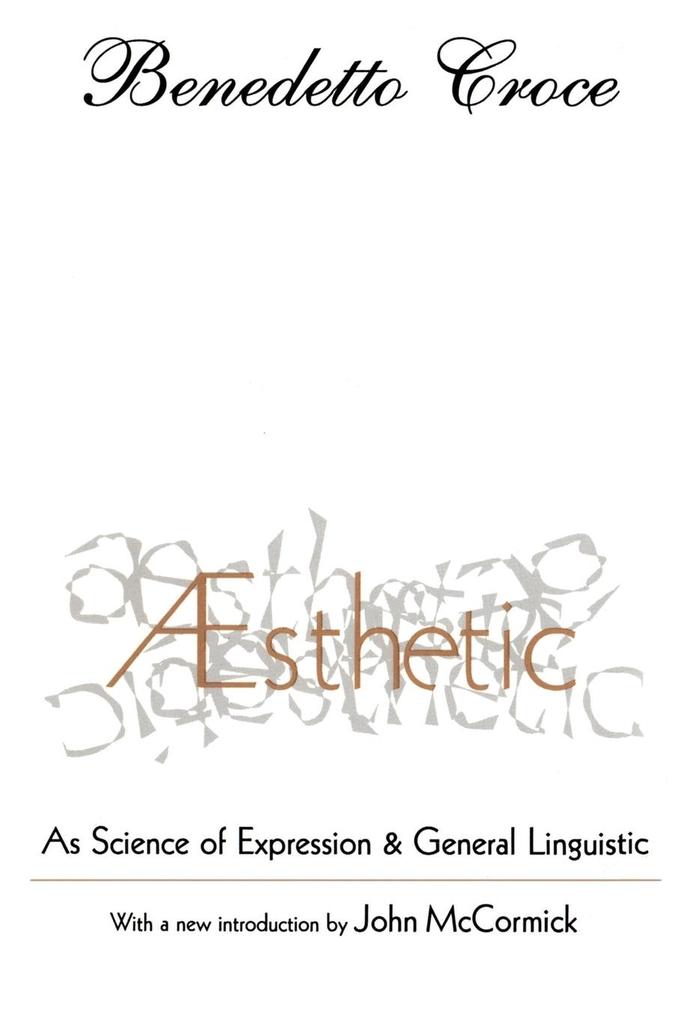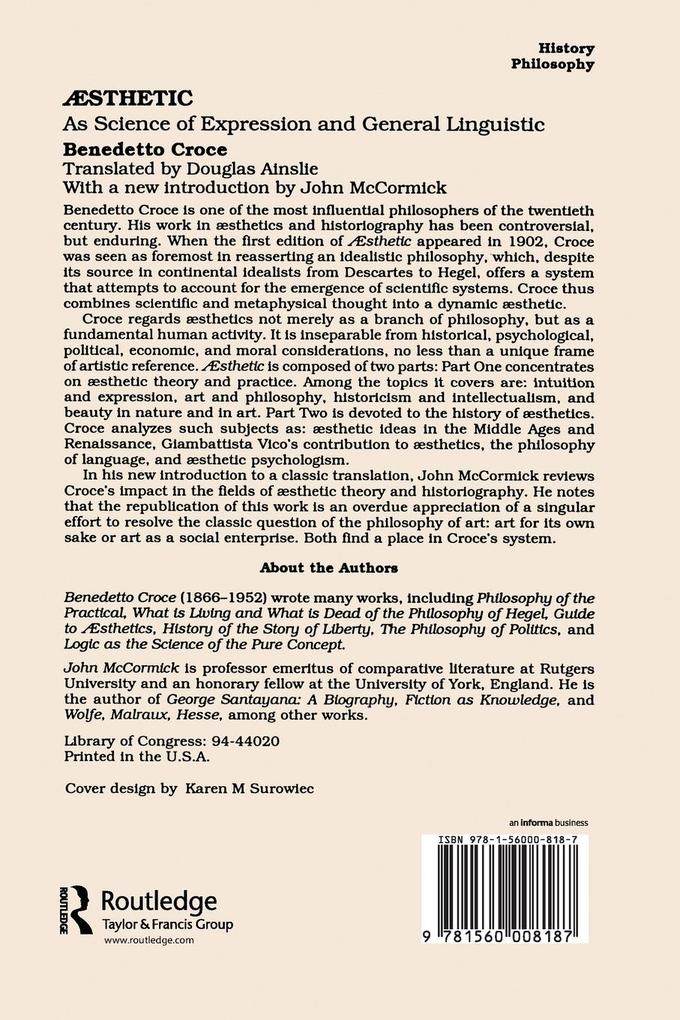
Zustellung: Do, 12.06. - Mo, 16.06.
Versand in 6 Tagen
VersandkostenfreiBestellen & in Filiale abholen:
Benedetto Croce is one of the most influential philosophers of the twentieth century. His work in aesthetics and historiography has been controversial, but enduring. When the first edition of ^Esthetic appeared in 1902, Croce was seen as foremost in reasserting an idealistic philosophy, which despite its source in continental idealists from Descartes to Hegel, offers a system that attempts to account for the emergence of scientific systems. Croce thus combines scientific and metaphysical thought into a dynamic aesthetic.
Croce regards aesthetics not merely as a branch of philosophy, but as a fundamental human activity. It is inseparable from historical, psychological, political, economic, and moral considerations, no less than a unique frame of artistic reference. Aesthetic is composed of two parts: Part One concentrates on aesthetic theory and practice. Among the topics it covers are: intuition and expression, art and philosophy, historicism and intellectualism, and beauty in nature and in art. Part Two is devoted to the history of aesthetics. Croce analyzes such subjects as: aesthetic ideas in the Middle Ages and Renaissance, Giambattista Vico as the inventor of aesthetic science, the philosophy of language, and aesthetic psychologism.
In his new introduction to a classic translation, John McCormick assesses Croce's influence in aesthetic theory and historiography. He notes that the republication of this work is an overdue appreciation of a singular effort to resolve the classic questions of the philosophy of art, art for its own sake and art as a social enterprise; both find a place in Croce's system.
Croce regards aesthetics not merely as a branch of philosophy, but as a fundamental human activity. It is inseparable from historical, psychological, political, economic, and moral considerations, no less than a unique frame of artistic reference. Aesthetic is composed of two parts: Part One concentrates on aesthetic theory and practice. Among the topics it covers are: intuition and expression, art and philosophy, historicism and intellectualism, and beauty in nature and in art. Part Two is devoted to the history of aesthetics. Croce analyzes such subjects as: aesthetic ideas in the Middle Ages and Renaissance, Giambattista Vico as the inventor of aesthetic science, the philosophy of language, and aesthetic psychologism.
In his new introduction to a classic translation, John McCormick assesses Croce's influence in aesthetic theory and historiography. He notes that the republication of this work is an overdue appreciation of a singular effort to resolve the classic questions of the philosophy of art, art for its own sake and art as a social enterprise; both find a place in Croce's system.
Inhaltsverzeichnis
I: Theory of Æsthetic; I: Intuition and Expression; II: Intuition and Art; III: Art and Philosophy; IV: Historicism and Intellectualism in Æsthetic; V: Analogous Errors in the Theory of History and in Logic; VI: The Theoretic Activity and the Practical Activity; VII: Analogy Between the Theoretic and the Practical; VIII: Exclusion of Other Spiritual Forms; IX: Indivisibility of Expression Into Modes or Degrees and Criticism of Rhetoric; X: Æsthetic Feelings and the Distinction Between the Beautiful and the Ugly; XI: Criticism of Æsthetic Hedonism; XII: The Æsthetic of the Sympathetic and Pseudo-Æsthetic Concepts; XIII: The "Physically Beautiful" in Nature and in Art; XIV: Errors Arising from the Confusion Between Physics and Æsthetic; XV: The Activity of Externalization. Technique and the Theory of the Arts; XVI: Taste and the Reproduction of Art; XVII: The History of Literature and Art; XVIII: Conclusion: Identity of Linguistic and Æsthetic; II: History of Æsthetic; I: Æsthetic Ideas in GræCo-Roman Antiquity; II: Æesthetic Ideas in the Middle Ages and Renaissance; III: Ferments of Thought in the Seventeenth Century; IV: Æesthetic Ideas in the Cartesian and Leibnitian Schools, And the "Æsthetic" of Baumgarten; V: Giambattista Vico; VI: Minor Æsthetic Doctrines of the Eighteenth Century; VII: Other Æsthetic Doctrines of the Same Period; VIII: Immanuel Kant; IX: The Æsthetic of Idealism: Schiller, Schelling, Solger, Hegel; X: Schopenhauer and Herbart; XI: Friedrich Schleiermacher; XII: The Philosophy of Language: Humboldt and Steinthal; XIII: Minor German Æstheticians; XIV: Æsthetic in France, England and Italy During the First Half of the Nineteenth Century; XV: Francesco De Sanctis; XVI: Æsthetic of the Epigoni; XVII: Æsthetic Positivism and Naturalism; XVIII: Æsthetic Psychologism and Other Recent Tendencies; XIX: Historical Sketches of Some Particular Doctrines; I: Rhetoric: Or the Theory of Ornate Form; II: History of the Artistic and Literary Kinds; III: The Theory of the Limits of the Arts; IV: Other Particular Doctrines; Bibliographical Appendix
Produktdetails
Erscheinungsdatum
15. April 1994
Sprache
englisch
Seitenanzahl
526
Herausgegeben von
Benedetto Croce
Verlag/Hersteller
Produktart
kartoniert
Gewicht
753 g
Größe (L/B/H)
229/152/28 mm
ISBN
9781560008187
Entdecken Sie mehr
Bewertungen
0 Bewertungen
Es wurden noch keine Bewertungen abgegeben. Schreiben Sie die erste Bewertung zu "Aesthetic" und helfen Sie damit anderen bei der Kaufentscheidung.










